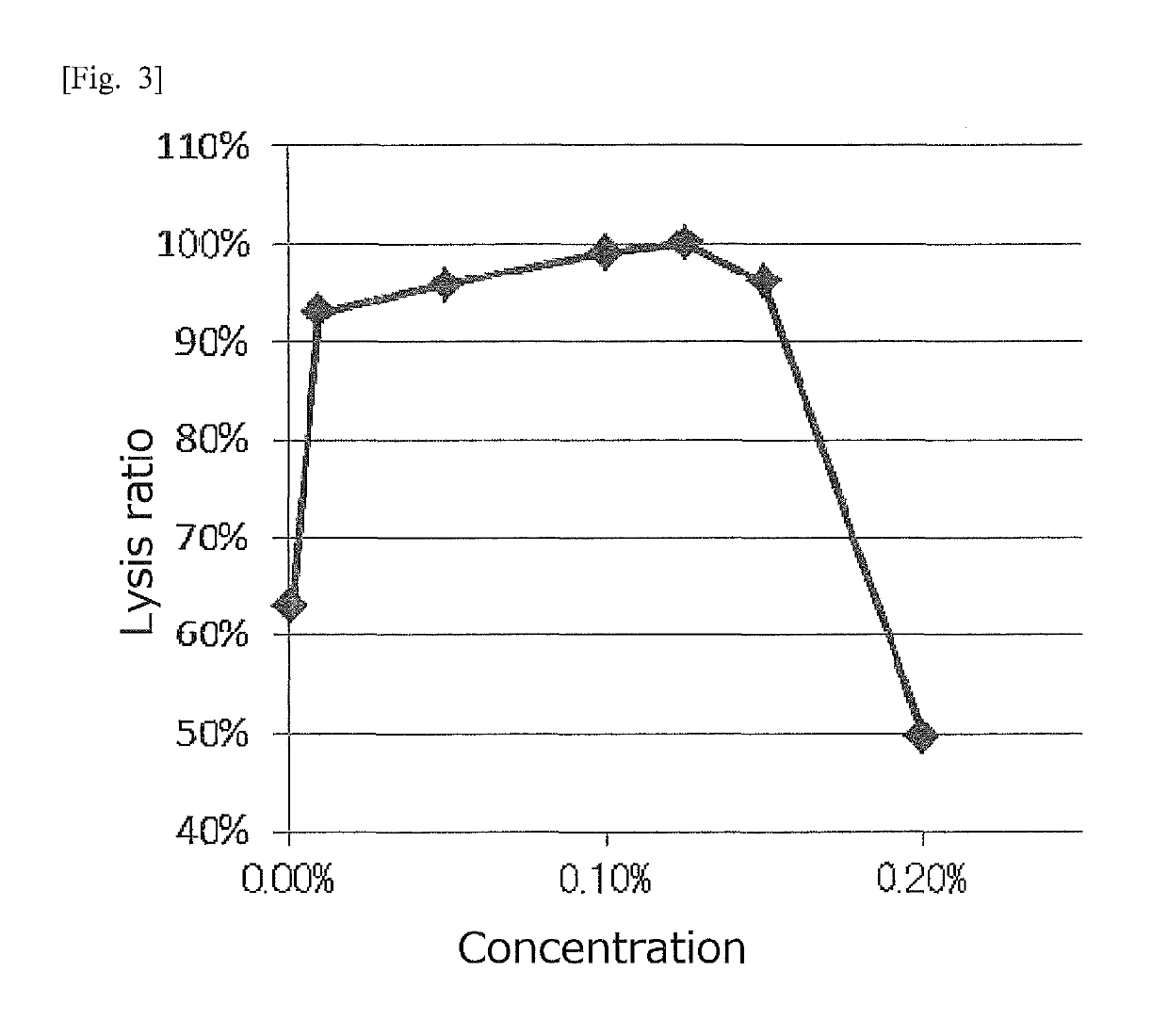Method for detecting coliform bacteria contained in milk
a technology of coliform bacteria and detection method, which is applied in the field of lysis method and detection method for detecting coliform bacteria, can solve the problems of insufficient lysis of conventional techniques, inability to achieve sufficient lysis, and inability to detect coliform bacteria on the spot, etc., and achieves the effect of convenient detection, quick detection and high detection accuracy
- Summary
- Abstract
- Description
- Claims
- Application Information
AI Technical Summary
Benefits of technology
Problems solved by technology
Method used
Image
Examples
example 1
Effect of Sodium Dodecylsulfate (SDS) in the Presence of Lysozyme and Nonionic Surfactant in Detection of Escherichia Coli by Immunochromatographic Method
(1) Preparation of Monoclonal Antibody Directed to Ribosomal Protein L7 / L12
[0098]As the antibody to be labeled with gold colloid, Escherichia coli ribosomal protein L7 / L12 monoclonal antibody was used. According to the method described in International Patent Publication WO00 / 06603, Example 5, the Escherichia coli L7 / L12 ribosomal protein was obtained, and monoclonal antibodies were prepared by using this protein. Among the monoclonal antibodies, a combination of two kinds of monoclonal antibodies (EC-1 and EC-2) that can simultaneously bind to different sites of the L7 / L12 ribosomal protein of the aforementioned bacterium or other coliform bacteria was selected.
(2) Preparation of Immunochromatographic Device
[0099]An immunochromatographic device was prepared as follows.
(a) Gold Colloid-Labeled Antibody-Impregnated Member
[0100]A gol...
example 2
Effect of Sodium Dodecylsulfate (SDS) in the Presence of Lytic Enzyme and Nonionic Surfactant in Detection of Escherichia Coli by Immunochromatographic Method
[0108]Measurement for cow's milk using the immunochromatographic device was performed as follows.
[0109]Milk (100 μl) containing Escherichia coli at a final concentration of 1×105 (cfu / ml) was put into a microtube, 150 μl of a lysis treatment solution (1% (final concentration) of Triton X-100, 2.2 mg / ml of lysozyme, 0.1 M MOPSO, pH 7.5) was added to the milk and mixed therein at room temperature, and the resulting mixture was left standing for 10 minutes. As the cow's milk, marketed milk for drinking was used. The aforementioned immunochromatographic device was immersed into the above mixed solution from the member 4 for sample addition, chromatographic development was carried out by leaving the device standing at room temperature for 30 minutes, and then for determining the presence or absence of capture of the complex of the r...
example 3
Measurement in Milk Sample by Immunochromatographic Method
[0111]An immunochromatographic method was performed for a milk sample obtained from a cow with mastitis. The measurement was performed in the same manner as that of Example 2, and the appeared reddish purple line was visually examined (positive +, negative −). The results obtained with lysis treatment solutions containing 1% (final concentration) of Triron X, 0.1 M MOPSO, pH 7.5, and 2.2 mg / ml of lysozyme, and containing or not containing 0.01% SDS (final concentration for the both) were compared. Separately, in order to confirm the number of Escherichia coli in the milk, quantification was performed by quantitative PCR. Genomic DNA was extracted from the milk (100 μl) by using DNA Mini Kit (Qiagen), and then PCR was performed by using Quantification of Escherichia coli (all strains) (PrimerDesign) to quantify the amount of Escherichia coli contained in the milk.
[0112]The numbers of Escherichia coli calculated by PCR and the ...
PUM
| Property | Measurement | Unit |
|---|---|---|
| concentration | aaaaa | aaaaa |
| concentration | aaaaa | aaaaa |
| concentration | aaaaa | aaaaa |
Abstract
Description
Claims
Application Information
 Login to View More
Login to View More - R&D
- Intellectual Property
- Life Sciences
- Materials
- Tech Scout
- Unparalleled Data Quality
- Higher Quality Content
- 60% Fewer Hallucinations
Browse by: Latest US Patents, China's latest patents, Technical Efficacy Thesaurus, Application Domain, Technology Topic, Popular Technical Reports.
© 2025 PatSnap. All rights reserved.Legal|Privacy policy|Modern Slavery Act Transparency Statement|Sitemap|About US| Contact US: help@patsnap.com


